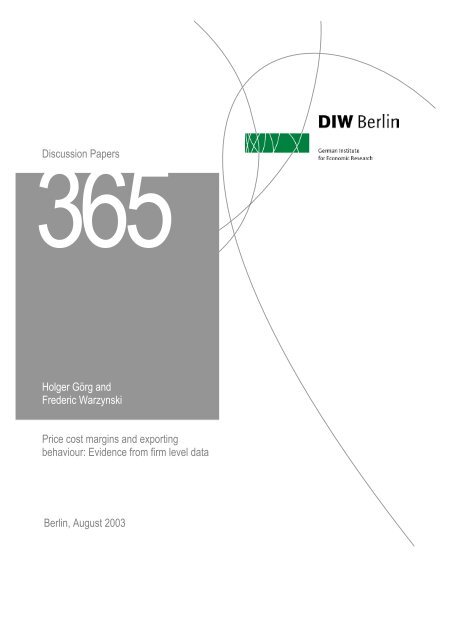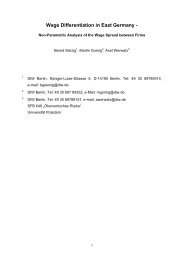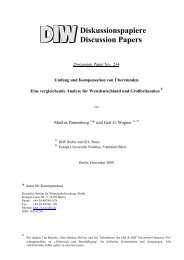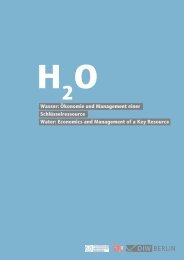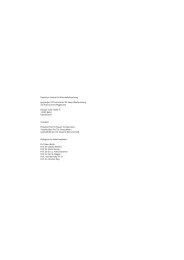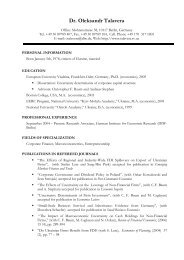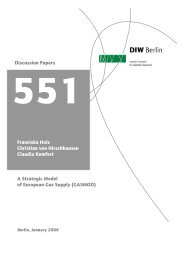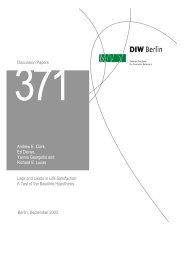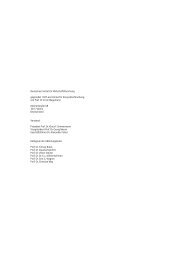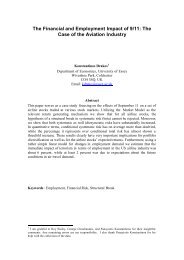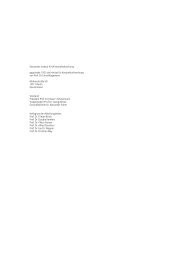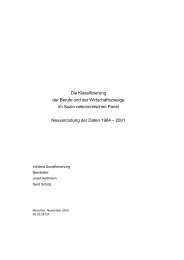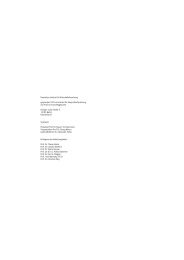Holger Görg and Frederic Warzynski Price cost margins ... - DIW Berlin
Holger Görg and Frederic Warzynski Price cost margins ... - DIW Berlin
Holger Görg and Frederic Warzynski Price cost margins ... - DIW Berlin
You also want an ePaper? Increase the reach of your titles
YUMPU automatically turns print PDFs into web optimized ePapers that Google loves.
Discussion Papers<br />
<strong>Holger</strong> <strong>Görg</strong> <strong>and</strong><br />
<strong>Frederic</strong> <strong>Warzynski</strong><br />
<strong>Price</strong> <strong>cost</strong> <strong>margins</strong> <strong>and</strong> exporting<br />
behaviour: Evidence from firm level data<br />
<strong>Berlin</strong>, August 2003
Opinions expressed in this paper are those of the author <strong>and</strong> do not necessarily reflect views<br />
of the Institute.<br />
<strong>DIW</strong> <strong>Berlin</strong><br />
German Institute<br />
for Economic Research<br />
Königin-Luise-Str. 5<br />
14195 <strong>Berlin</strong>,<br />
Germany<br />
Phone +49-30-897 89-0<br />
Fax +49-30-897 89-200<br />
www.diw.de<br />
ISSN 1619-4535
<strong>Price</strong> <strong>cost</strong> <strong>margins</strong> <strong>and</strong> exporting behaviour:<br />
Evidence from firm level data ∗<br />
<strong>Holger</strong> <strong>Görg</strong> † <strong>and</strong> <strong>Frederic</strong> <strong>Warzynski</strong> ‡<br />
22 July 2003<br />
Abstract<br />
This paper examines whether exporting activity matters for firm’s<br />
price <strong>cost</strong> <strong>margins</strong>. The recent literature on exporting <strong>and</strong> productivity<br />
shows that exporters on average are more efficient than nonexporters.<br />
If that is the case we may also expect them to have different<br />
mark-ups. We investigate this issue using company level data for<br />
UK manufacturing industries. The measurement of mark-ups follows<br />
the recent approach presented by Roeger (1995). Our results show<br />
that, on average, exporters have higher mark-ups than non-exporters.<br />
We also distinguish sectors into homogeneous <strong>and</strong> differentiated goods<br />
producing. This distinction shows that we only find higher mark-ups<br />
for exporters in differentiated goods sectors, not in homogeneous sectors.<br />
JEL Classifications: F1, L1, L6<br />
Keywords: exports, mark-ups, price <strong>cost</strong> <strong>margins</strong>, productivity<br />
∗ Earlier versions of the paper were presented at Nottingham University, Örebro University<br />
<strong>and</strong> IIIS Dublin. We are particularly grateful to Andrew Bernard, Rod Falvey,<br />
Joep Konings, Nannan Lundin, Daniel Mirza, Steve Redding, Andrew Schott <strong>and</strong> Eric<br />
Strobl for helpful comments <strong>and</strong> discussions. Financial support from the Leverhulme<br />
Trust (Grant No. F114/BF) is gratefully acknowledged.<br />
† University of Nottingham <strong>and</strong> <strong>DIW</strong> <strong>Berlin</strong>, email holger.gorg@nottingham.ac.uk<br />
‡ IDEI-University of Toulouse, email warzynsk@cict.fr<br />
1
1 Introduction<br />
Theissueofwhetherfirms that export have productivity advantages over<br />
non-exporters has been the subject of much research <strong>and</strong> debate recently.<br />
Evidence showing such a productivity advantage is plentiful, see, for example,<br />
the papers by Clerides et al. (1998) for Colombia, Mexico <strong>and</strong> Morocco,<br />
Bernard <strong>and</strong> Jensen (1999) for the US, Girma et al. (2003) for the UK <strong>and</strong><br />
Hallward-Driemeier et al. (2002) for a number of East Asian countries. 1 A<br />
related question that comes to mind is whether this apparent productivity<br />
advantage also has an effect on the competitiveness of exporters compared<br />
to non-exporters. To be more precise, are exporters that have an apparent<br />
productivity advantage also able to sustain higher price <strong>cost</strong> <strong>margins</strong> than<br />
non-exporters? This question, which does not appear to have been addressed<br />
in the existing literature, is the topic of this paper.<br />
If markets are less than perfectly competitive firms are able to charge<br />
prices higher than marginal <strong>cost</strong>, i.e., their mark-up defined as the ratio of<br />
price over marginal <strong>cost</strong> (p/mc) will be greater than one. The evidence that<br />
mark-ups exist is widespread (e.g., Hall, 1988, Roeger, 1995, Konings et al.,<br />
2001) <strong>and</strong> is taken as evidence that competition is less than perfect. Much<br />
has been written about the effect of import competition on mark-ups <strong>and</strong><br />
this literature has recently been reviewed by Tybout (2001). Trade theoretic<br />
models (e.g., Krugman, 1979, Br<strong>and</strong>er, 1981) show that a move from autarky<br />
to free trade will lead to increases in output through imports, resulting in<br />
stronger competition <strong>and</strong> hence reductions in the mark-up. Empirical studies<br />
that look at the link between import competition <strong>and</strong> mark-ups are provided<br />
by, for example, Levinsohn (1993), Harrison (1994), Katics <strong>and</strong> Petersen<br />
(1994), Krishna <strong>and</strong> Mitra (1998) <strong>and</strong> Co (2001). These studies generally<br />
find that increases in imports, or reductions in trade protection, are related<br />
with decreasing mark-ups.<br />
This paper examines the trade - competition link from a slightly different<br />
point of view. We investigate empirically whether exporting activity is<br />
related to firms’ price <strong>cost</strong> <strong>margins</strong>.<br />
Bernard et al. (2003) have recently provided a model based on imperfect<br />
competition that links firm level efficiency, firm specific mark-ups <strong>and</strong><br />
exporting activity of a firm in a consistent way. In imperfectly competi-<br />
1 Much of the recent debate focusses on whether firms learn through exporting (e.g.,<br />
Girma et al. 2003a) or whether more productive firms self select into exporting (e.g.,<br />
Bernard <strong>and</strong> Jensen, 1999 <strong>and</strong> Clerides et al. 1998).<br />
2
tive markets, firms charge a price equal to a mark-up over marginal <strong>cost</strong>,<br />
pi = mi(c/zi), where mi is the firm specific mark-up,c is the <strong>cost</strong> of inputs<br />
<strong>and</strong> zi is a measure of efficiency of firm i. Then, measured productivity of<br />
firm i is pizi = miw which varies if mi varies across firms.<br />
Their simple model yields two testable predictions. First, since more<br />
efficient producers are also likely to have more efficient rivals, they are likely<br />
to charge lower prices, sell more on the domestic market <strong>and</strong> also beat rivals<br />
on export markets, i.e., they are more likely to become exporters. 2 As pointed<br />
out above, a large literature analyses this issue, mostly confirming the theory.<br />
Second,inamodelwithBertr<strong>and</strong>competition,moreefficient producers have<br />
a <strong>cost</strong> advantage over their competitors, set higher mark-ups <strong>and</strong> have higher<br />
levels of measured productivity. Hence, more efficient producers set higher<br />
mark-ups <strong>and</strong> are also more likely to become exporters.<br />
Our paper tests the implication that there is a relationship between firms<br />
price <strong>cost</strong> <strong>margins</strong> <strong>and</strong> export intensity empirically, using a large sample of<br />
firms from UK manufacturing sector. We contribute to the literature in a<br />
number of other ways. As pointed out above, while there is a large literature<br />
studying the effect of import competition on PCMs <strong>and</strong> the link between<br />
exporting <strong>and</strong> productivity, this is, to the best of our knowledge, the first<br />
paper that looks at the implications of exporting for mark-ups of exporters<br />
compared to non-exporters. Furthermore, our paper is the firstthatweare<br />
aware of that calculates price-<strong>cost</strong> <strong>margins</strong> using the approach developed by<br />
Hall (1988) <strong>and</strong> Roeger (1995) for the UK using firm level panel data. 3<br />
The remainder of the paper is structured as follows. Section 2 briefly<br />
introduces the methodology used to estimate PCMs, following the approach<br />
proposed by Hall (1988) <strong>and</strong> Roeger (1995). Section 3 describes our firm level<br />
dataset. The results are divided in two sub-sections: Section 4.1 provides<br />
estimates of average PCMs, in manufacturing industry as a whole <strong>and</strong> in<br />
mode disaggregated subsets, while Section 4.2 analyses more precisely the<br />
effect of exporting. Section 5 concludes.<br />
2 The theoretical result that more efficient firms are more likely to become exporters<br />
is similar to Melitz (2003). However, Melitz’s paper assumes constant mark-ups which<br />
makes it less relevant for our analysis.<br />
3 Small (1997) calculates PCMs for UK manufacturing using industry level data. As<br />
we discuss in more detail below, firm level data can be considered to be more appropriate<br />
to study this issue. Griffith (2001) attempts to measure PCMs using observed data on<br />
total output divided by total <strong>cost</strong>s (assuming that AC = MC).<br />
3
2 Methodology<br />
The calculation of price <strong>cost</strong> <strong>margins</strong> is not straightforward as it is difficult<br />
to observe marginal <strong>cost</strong>s. In the past, many studies used accounting data<br />
on profitability, or sales minus expenditures on labour <strong>and</strong> materials for the<br />
calculation (see Tybout, 2001). However, Bresnahan (1987) argues forcefully<br />
against the use of such accounting data on profits as “there is no stable<br />
time-series relationship between accounting profit <strong>and</strong> price-<strong>cost</strong> <strong>margins</strong> in<br />
the economic sense” (p. 460) due to the way in which different accounting<br />
practices deal with fixed <strong>cost</strong>s.<br />
In order to avoid such issues, our methodology to calculate price <strong>cost</strong><br />
<strong>margins</strong> (PCMs) is based on Hall (1988) <strong>and</strong> Roeger (1995). These papers<br />
attempt to estimate Solow residuals under imperfect competition which, almost<br />
as a by-product, allows the estimation of PCMs.<br />
To implement such an approach we start from a st<strong>and</strong>ard production<br />
function<br />
Qit = ΘitF (Kit,Nit,Mit)<br />
where i is a firm index, t atimeindex,Kit is capital stock (selected in advance<br />
of the realisation of dem<strong>and</strong>), Nit is labour input, Mit is material input <strong>and</strong><br />
Θit is the Hicks neutral technical progress. Assuming imperfect competition<br />
in the final goods market where firms set prices higher than marginal <strong>cost</strong>s,<br />
Hall (1988) <strong>and</strong> Domowitz et al. (1988) show that under constant returns to<br />
scale the Solow residual (i.e., total factor productivity (TFP)) can be written<br />
as<br />
SR = ∆qit − αNit∆nit − αMit∆mit − (1 − αNit − αMit)∆kit<br />
= β it(∆qit − ∆kit)+(1− β it) ϑit<br />
where ∆xit are the growth rates (in log differences) of output (q), labour<br />
(n), materials (m) <strong>and</strong>capital(k), the αit are the shares of inputs in total<br />
turnover (αJit = pJitJit/pitQit∀J = N,M) <strong>and</strong>ϑit = ∆ log (Θit) is the unobserved<br />
productivity term.<br />
The coefficient β it is of special interest as it is equal to the price cot<br />
margin,orLernerindex<br />
β it = pit − mcit<br />
pit<br />
4<br />
=1− 1<br />
µ it<br />
(1)
which in turn allows one to retrieve the markup µ it = pit/mcit.<br />
Hall (1988) <strong>and</strong> Domowitz et al. (1988) suggest that µ can be retrieved<br />
from estimating specifications of equation (1) <strong>and</strong> this approach has been<br />
followed in a number of empirical studies (for example, Levinsohn, 1993,<br />
Harrison, Konings et al., 2001). However, the problem with such an estimation<br />
is that the explanatory variables are potentially correlated with the<br />
unobserved productivity term ϑit. Hence, consistent estimation of equation<br />
(1) relies on the use of suitable instruments for the right-h<strong>and</strong>-side variables,<br />
which are potentially endogenous. The selection of proper instruments has,<br />
however, turned out to be rather difficult in practice.<br />
Roeger (1995) discusses this problem in some detail <strong>and</strong> suggests an alternative<br />
approach that does not rely on ”the use of instruments that are very<br />
hard to select” (p. 318). His proposed technique for estimating price-<strong>cost</strong><strong>margins</strong><br />
stems from his idea that the difference between the primal Solow<br />
residual as described in equation (1) <strong>and</strong> its price-based dual (derived from<br />
a <strong>cost</strong> function) is due to imperfect competition.<br />
Hence, starting off with the primal Solow residual derived from the production<br />
function as in equation (1) we can write a similar expression for the<br />
price-based Solow residual (SRPit)<br />
SRPit = αNit∆wit + αMit∆pMit +(1− αNit − αMit) ∆rit − ∆pit<br />
= −βit (∆pit − ∆rit)+(1−βit) ϑit<br />
(2)<br />
where ∆wit, ∆pMit, ∆rit, ∆pit are the growth rates of the price for labour<br />
(i.e., wage), materials, capital (i.e., rental rate for capital) <strong>and</strong> output. Subtracting<br />
SRP from SR yields<br />
SRit − SRPit = ∆qit + ∆pit − αNit(∆nit + ∆wit) − αMit(∆mit + ∆pMit)<br />
−(1 − αNit − αMit)(∆kit + ∆rit)<br />
= βit [(∆qit + ∆pit) − (∆kit + ∆rit)]<br />
which cancels out the unobserved productivity term (1 − β it) ϑit. Rewriting<br />
the left h<strong>and</strong> side as ∆y <strong>and</strong> the right h<strong>and</strong> side as ∆x <strong>and</strong> adding a<br />
r<strong>and</strong>om error term uit yields:<br />
∆yit = βit∆xit + uit<br />
(3)<br />
Roeger (1995) argues that this expression can be estimated using OLS<br />
because the error term in this case is not correlated with the regressor, i.e.,<br />
5
there is no endogeneity problem. Hence, there is no need to use instrumental<br />
variables. Equation (3) is the key equation to be estimated.<br />
As discussed extensively by Roeger (1995) pp. 321-324, there are a variety<br />
of reasons why the error term should not be identical to zero for all i <strong>and</strong><br />
all t. In particular, in the case of excess capacity <strong>and</strong> labor hoarding, the<br />
difference between the primal <strong>and</strong> the dual Solow residual is cyclical, which<br />
would be captured by the error term. We use year dummies to capture<br />
potential dem<strong>and</strong> effects. However, Roeger finds that the goodness of fit<br />
is relatively high, <strong>and</strong> that adding conjectural factors does not add much<br />
explanatory power.<br />
To make our analysis econometrically feasible, we need to impose some<br />
identifying restrictions. It is not possible to estimate price-<strong>cost</strong> <strong>margins</strong><br />
for each firm separately using this approach. We have at our disposal a firm<br />
level panel dataset. Therefore, we can estimate β for a given time period (βt) assuming that price-<strong>cost</strong> <strong>margins</strong> are the same for all firmsinagivenyear,for<br />
a given industry ³ ´<br />
βj assuming PCMs to be identical for all firms within the<br />
same sector, or for a given period <strong>and</strong> a given industry ³ ´<br />
βjt . This technique<br />
allows much more flexibility than what has been used in the literature thus<br />
far as we can estimate the evolution of mark-ups over time by sector <strong>and</strong><br />
therefore capture more of the heterogeneity present in our sample.<br />
A number of issues arise when estimating price-<strong>cost</strong>-<strong>margins</strong> using this<br />
approach. First, there is the question of whether to use firm or industry level<br />
data to estimate the above equations. Clearly, the empirical methodology<br />
isbasedonamodeloffirm behaviour <strong>and</strong>, therefore, firm level data should<br />
be most appropriate to estimate the model. However, the literature has<br />
mostly used industry level data (see Hall, 1988, Roeger, 1998). As is well<br />
known, industry level data may lead to biased results as they aggregate over<br />
potentially heterogenous units. Our dataset provides us with firm level data<br />
for UK manufacturing industries which are arguably more appropriate for<br />
such an analysis. 4<br />
Second, it is difficult to believe that the degree of market power has remained<br />
constant over time. Nevertheless, most studies estimate the average<br />
markup over a period. Exceptions are studies using firm level data with a<br />
smaller time span <strong>and</strong>/or trying to capture structural adjustments (Levin-<br />
4 See also Konings <strong>and</strong> V<strong>and</strong>enbussche (2002) for a recent application of this method<br />
using firm level data. They analyse the effect of antidumping protection on price <strong>cost</strong><br />
<strong>margins</strong> of European firms.<br />
6
sohn, 1993; Konings et al., 2001) <strong>and</strong> sector studies trying to control for<br />
changes in some exogenous parameters like trade (Hakura, 1998) or the nature<br />
of antitrust control (<strong>Warzynski</strong>, 2001). We allow for changes in mark-ups<br />
over time in the estimations of equation (3).<br />
Third, we can also look more closely at some firm level characteristics that<br />
might be associated with higher price <strong>cost</strong> <strong>margins</strong>. As pointed out above,<br />
the main aim of the paper is to analyse whether exporting activity impacts on<br />
price <strong>cost</strong> <strong>margins</strong>. To do this, reconsider equation (3) <strong>and</strong> assume that the<br />
coefficient β it is made up of two components, capturing the average mark-up<br />
for non-exporters plus a term allowing for a difference in mark-ups between<br />
exporters <strong>and</strong> non-exporters, i.e.,<br />
β it =(β 1 + β 2 ∗ EDit)<br />
where EDit is a dummy variable equal to 1 if the firm is an exporter. We can<br />
estimate these two components of the mark-up by substituting this expression<br />
back into equation (3) <strong>and</strong> re-arranging, which yields<br />
∆yit = β 1∆xit + β 2EDit ∗ ∆xit + uit<br />
If exporters indeed have different price-<strong>cost</strong> <strong>margins</strong> we would expect β 2<br />
to be statistically significantly different from zero.<br />
Similarly, we investigate whether export intensity affects price <strong>cost</strong> <strong>margins</strong><br />
by estimating the following equation<br />
∆yit = β 3∆xit + β 4EIit ∗ ∆xit + vit<br />
for all firmsaswellasforexportingfirms only, where EIit is a firm’s<br />
export intensity defined as exports over total turnover. Again, if exporting<br />
activity matters we would expect β 4 to be statistically significantly different<br />
from zero.<br />
It is worth noting that, while the derivations of the dual Solow residual assumes<br />
constant markup, it is straightforward to relax this assumption, adding<br />
necessary controls, as shown by Oliveira Martins <strong>and</strong> Scarpetta (2002).<br />
Finally, what we are testing is the joint hypothesis of perfect competition<br />
<strong>and</strong> constant returns to scale (see also Basu <strong>and</strong> Fernald, 1997 p. 253).<br />
While the Hall approach allows the joint estimation of both parameters, this<br />
estimation is more complicated with the Roeger approach.<br />
7<br />
(4)<br />
(5)
3 Dataset<br />
The analysis is based on company level data taken from the OneSource<br />
database which is compiled by OneSource Information Services Ltd. 5 The<br />
OneSource database is a subset of all actively trading companies which are<br />
legally required to deposit company accounts data at Companies House. It<br />
includes information on the top 110,000 private <strong>and</strong> public companies in all<br />
industries (not just manufacturing) in the United Kingdom. Specifically,<br />
the data include (i) all plcs, (ii) all companies with employment greater than<br />
50, (iii) the top companies based on turnover, net worth, total assets, or<br />
shareholders’ funds (whichever is the largest), up to a maximum of 110,000<br />
companies (Hart <strong>and</strong> Oulton, 1995).<br />
This dataset is particularly suitable for our purposes as it is one of the few<br />
datasets to contain recent firm level data on exports. 6 Also, it provides recent<br />
firm level data on, inter alia, output, employment, physical capital, wages<br />
<strong>and</strong> accounting data in a consistent way across firms in the UK. Furthermore,<br />
it has a time series element allowing investigation of the development of price<br />
<strong>cost</strong> <strong>margins</strong> over time. The data available to us cover the period 1990 to<br />
1996.<br />
Since the purpose of this study is to look at the relationship between<br />
exporting <strong>and</strong> price-<strong>cost</strong> <strong>margins</strong> we focus on private manufacturing firms<br />
only, dropping all public or non-manufacturing firms from the sample. We<br />
also drop firms that were ultimate holding companies or subsidiaries under<br />
joint ownership, 7 firms that have average employment or turnover levels of<br />
zero, or growth rates for wages or turnover of more than 200 percent or less<br />
than -200 percent in the data, <strong>and</strong> firms for which the ownership indicator<br />
(which indicates whether the firm is private/public owned, whether it is<br />
independent etc) is missing. Furthermore, in order to mitigate the impact<br />
of outliers in the regressions we excluded the top <strong>and</strong> bottom 5 percentile<br />
observations in terms of ∆yit <strong>and</strong> ∆xit.<br />
5 We used the OneSource CD-ROM entitled ”UK Companies, Vol. 1” for May 1998.<br />
See, for example, Girma et al. (2003) <strong>and</strong> Hart <strong>and</strong> Oulton (1996) for other papers<br />
using other vintages of the same database. Hart <strong>and</strong> Oulton (1995) provide a thorough<br />
description <strong>and</strong> discussion of the dataset.<br />
6 Note that micro level data on exporting are not available in the ARD database, the<br />
micro-level database provided by the Office for National Statistics (ONS) in the UK.<br />
7 These were dropped as it may lead to double counting if firms have consolidated<br />
accounts.<br />
8
After these operations our dataset contains information on 5,834 firms.<br />
The median number of observations per firm is 4. The mean employment in<br />
these firms over the total period is 329, with the median being 97 employees.<br />
2,644 firms enter <strong>and</strong> there are 2,395 exits from the sample over the period<br />
analysed. Of the firms included in the sample, 2,410 are exporters throughout<br />
the sample period, 2,659 never export <strong>and</strong> the remaining 765 exported in at<br />
least one year during the sample period.<br />
For the discussion of the variables included in the empirical estimation it<br />
is useful to rewrite equation (3) as follows<br />
∆ log ORit − αNit∆ log CEit − αMit∆ log CMit<br />
−αKit (∆ log NKit + ∆ log Rit) (6)<br />
= β it [∆ log ORit − (∆ log NKit + ∆ log Rit)]<br />
OR is operating revenue, CE is total <strong>cost</strong> of employees, CM is total <strong>cost</strong><br />
of materials <strong>and</strong> NK is tangible fixed assets net of depreciation. All of<br />
these variables are available at the firm level from our dataset. Note that all<br />
variables are specified in nominal terms which is a further advantage of the<br />
Roeger method compared to others. Rit istheuser<strong>cost</strong>ofcapital,defined<br />
as (see, for example, Hsieh, 2002)<br />
Rit = PI (r + δit)<br />
where δit is the firm-specific rate of depreciation on capital assets, available<br />
from the dataset. PI is the index of investment goods prices <strong>and</strong> r is<br />
the real interest rate. PI <strong>and</strong> r are at the country level <strong>and</strong> time varying.<br />
Table 1 presents some summary statistics on the growth rates of operating<br />
profits, capital stock, total <strong>cost</strong> of employees <strong>and</strong> <strong>cost</strong> of materials for 1996.<br />
Note that, in all cases, the growth rates are higher for non-exporters than<br />
for exporters, although this difference is only statistically significant at the<br />
five percent level in the case of the growth of operating revenue <strong>and</strong> <strong>cost</strong> of<br />
employees.<br />
[Table 1 here]<br />
9
4 Econometric Results<br />
As pointed out above, our analysis is based on firm level panel data for UK<br />
manufacturing industries. Since equations (3) to (6) are essentially twice<br />
differenced equations any possible firm specific unobservable effects that may<br />
impact on a firm’s production function are cancelled out. Hence we can use<br />
simple pooled regression techniques for the estimation. 8 We allow for heteroskedasticity<br />
of the error term, as well as an unspecified correlation between<br />
error terms within establishments, but not across establishments. This allows<br />
for the likely possibility that error terms within firms are correlated over<br />
time.<br />
4.1 Average price <strong>cost</strong> <strong>margins</strong><br />
We start with estimating equation (3) for the entire sample in order to provide<br />
a baseline of the average PCM in UK manufacturing firms. The results<br />
are reported in column (1) of Table 2. We report the coefficients of β it<br />
estimated from the regressions <strong>and</strong> the implied value of the mark-up µ it. The<br />
estimates of the Lerner index β it are statistically significantly different from<br />
zero, suggesting the existence of market power <strong>and</strong>, hence, deviations from<br />
perfect competition in UK manufacturing industries. The average mark-up<br />
is 1.12 which is well within the range of estimates provided by Small (1997)<br />
for a number of UK manufacturing industries.<br />
This estimation imposes the constraint that the average PCM is constant<br />
over time. In order to relax this assumption we constructed interaction terms<br />
of year dummies with ∆xit which are included in equation (3). Inclusion<br />
of the time interaction terms, i.e., allowing for changes in PCM over time in<br />
column (2) indicates a reduction in the average PCM for all years relative<br />
to 1990. While the focus of our paper is not on explaining the evolution of<br />
mark-ups over time, we note that this finding is in line with Griffith (2001)<br />
who argues that the European Single Market Programme, which became<br />
effectivein1992,ledtoanincreaseinproductmarketcompetitioninthe<br />
UK. Note that, in all specifications, we can reject the hypothesis that the<br />
interaction terms are jointly equal to zero. Hence the specification in column<br />
(2) should be preferred to column (1).<br />
8 We also replicated all estimations using a fixed effects estimator. In the majority of<br />
cases, a simple F test of the significance of the firm fixed effect rejects the specification,<br />
hence we prefer the pooled estimations as used here.<br />
10
These estimations, of course, average over a number of heterogeneous<br />
sub-sectors. In order to find more homogeneous comparison groups we estimatedequation(3)separatelyforfirms<br />
in differentiated <strong>and</strong> homogeneous<br />
good producing industries. 9 As is well known, a firm’s mark-up is affected<br />
by the degree of product differentiation. Hence, grouping firms together according<br />
to the level of product differentiation appears a reasonable empirical<br />
strategy.<br />
Theresultsoftheestimationsforthetwogroupsoffirms separately are<br />
reported in columns (3) to (6). We find differences in the average PCM between<br />
differentiated <strong>and</strong> homogeneous good producing industries. In order<br />
to check whether these differences are statistically significant we estimated<br />
the model on the whole sample including interaction terms of all variables<br />
withadummyequaltooneifthefirm is in a differentiated good industry.<br />
Without including the year interaction terms, the interaction term for ∆xit<br />
with the dummy is individually statistically significant (at the six percent<br />
level) suggesting a significant difference in PCMs between differentiated <strong>and</strong><br />
homogeneous goods producing industries. When including the time interaction<br />
terms, the coefficient is no longer statistically significant, however. 10<br />
This suggests that PCMs in the two different subsets of firms have followed<br />
different evolutions.<br />
[Table 2 here]<br />
4.2 The effect of exporting behaviour<br />
We now turn to the issue of whether exporting affects price-<strong>cost</strong> <strong>margins</strong> for<br />
those firms who do export. The first step is to estimate the simple premia<br />
to exporting, as described in equation (4). Note that with our approach all<br />
we can establish is whether or not there is a correlation between exporting<br />
<strong>and</strong> price-<strong>cost</strong> <strong>margins</strong>, we are agnostic about the causality of such possible<br />
effects. 11<br />
The result of this estimation for the whole manufacturing sector is presented<br />
in columns (1) <strong>and</strong> (2) of Table 3. Note that the average Lerner<br />
9 This distinction is based on a classification of industries used by Rauch (1999); details<br />
can be found in the appendix.<br />
10 The t- <strong>and</strong> F- values for these tests are not reported here but can be obtained from<br />
the authors. We also carried out similar tests for the results on exporting reported below.<br />
11 Bernard et al. (2003) also do not establish a causal link between exporting <strong>and</strong> price<br />
<strong>cost</strong> <strong>margins</strong> in their theoretical model.<br />
11
index is still positive <strong>and</strong> statistically significant. The inclusion of the export<br />
dummy only leads to a marginal changeincomparisontotheestimates<br />
presented in the preferred specification in column (2) of Table 2. The positive<br />
<strong>and</strong> statistically significant coefficient on the export interaction term<br />
(EDit ∗ ∆xit) suggests that exporters have, on average, higher price <strong>cost</strong><br />
<strong>margins</strong> than non-exporters. This is consistent with the theory discussed<br />
above,wheremoreefficient firms are more likely to export <strong>and</strong> have higher<br />
mark-ups. Based on the preferred specification in column (2), we find that<br />
exporters have an average mark-up that is about 1.2 percent higher than<br />
that for non-exporters.<br />
In order to investigate differences across broad industries we again break<br />
up the total sample into the differentiated <strong>and</strong> homogeneous goods groups.<br />
For differentiated goods industries we find a positive export premium. Taking<br />
the point estimates at face value, we find that the mark-up for exporters<br />
in these industries is about 2.5 percent higher than that for non-exporters.<br />
For homogeneous good industries, however, we find no statistically significant<br />
difference between exporters <strong>and</strong> non-exporters in terms of their PCMs.<br />
Again we checked whether the export premia are statistically significantly<br />
different between homogenous <strong>and</strong> differentiated goods sectors by estimating<br />
the model on the whole sample <strong>and</strong> including interaction terms of all<br />
variables with a differentiated good industry dummy. The coefficient on the<br />
export dummy interaction term is individually statistically significant, <strong>and</strong><br />
all interaction terms are jointly statistically significant also.<br />
This difference is probably what one would expect. In differentiated<br />
goods industries, firms can add a further dimension to product differentiation<br />
by exporting (i.e., differentiate geographically). This may then lead to<br />
exporters being able to increase their price <strong>cost</strong> <strong>margins</strong> through this further<br />
differentiation. This is not possible for exporters which sell homogeneous<br />
goods abroad as these are homogeneous on both domestic <strong>and</strong> foreign markets.<br />
[Table 3 here]<br />
A further question to ask is whether the extent of exporting activity is also<br />
related with the mark-ups firms charge. When we use the export intensity<br />
instead of the export dummy <strong>and</strong> interact with ∆x, wefind results similar<br />
to those found in the specification with the export dummy, as reported in<br />
Table 4.<br />
12
[Table 4 here]<br />
However, it may be more interesting to ask what the impact of the exporting<br />
intensity is conditional on the firm being an exporter. In order to<br />
address this point we estimate equation (5) using data on only firms that are<br />
exporters at any given time during the sample period. 12 Theresultsarereported<br />
in Table (5). The coefficients on the interaction terms EIit ∗ ∆xit are<br />
positive <strong>and</strong> statistically significant only for the case of homogeneous goods<br />
industries. However, performing a test as above by interacting all variables<br />
with a dummy for differentiated goods industries, we find that we cannot reject<br />
the hypothesis that the interaction term of EIit ∗ ∆xit with the dummy<br />
is equal to zero. Furthermore, we find that these interaction terms are not<br />
jointly statistically significant in either of the two specifications. Hence, we<br />
cannot conclude that there are any significant differences in the impact of<br />
exporting intensity on PCMs across these two sectoral groupings.<br />
[Table 5 here]<br />
Taken together, these results indicate that there is a difference between<br />
homogeneous <strong>and</strong> differentiated goods industries in terms of exporting only<br />
as far as the distinction between exporter - non-exporter is concerned. For<br />
firms in the differentiated goods industries it is important whether or not<br />
they are exporters in terms of their price <strong>cost</strong> margin, while there is no such<br />
effect apparent for firms in homogeneous goods industries.<br />
We also carried on our analysis using more disaggregated subsets of firms<br />
(2-digit NACE Rev.1) <strong>and</strong> our main results held on. We observed more<br />
heterogeneity by sector but we also noticed a difference depending on whether<br />
the sector was producing differentiated or homogeneous goods. The effects of<br />
exporting activity <strong>and</strong> exporting intensity were also in line with the results<br />
showninthissection.<br />
12 This sub-sample thus includes firms that enter <strong>and</strong> exit over the sample period. While<br />
we do not deal with the issue of entry <strong>and</strong> exit explicitly we also experimented using data<br />
for cohorts of entrants into exporting only. However, no clear-cut results were obtained<br />
<strong>and</strong> we therefore report the results for all exporters here.<br />
13
5 Summary <strong>and</strong> conclusions<br />
There exists a sizeable literature analysing the effect of import competition<br />
on domestic mark-ups. Our paper examines the trade - competition link from<br />
adifferent point of view by investigating whether exporting activity is related<br />
to firms’ price <strong>cost</strong> <strong>margins</strong>. Our paper is related to the recent literature on<br />
exporting <strong>and</strong> productivity, which shows that exporters on average are more<br />
efficient than non-exporters. Based on a model by Bernard et al. (2003) one<br />
may expect firms that are more efficient to charge higher mark-ups <strong>and</strong> to be<br />
more likely to become exporters. We investigate this issue using company<br />
level data for UK manufacturing industries. The measurement of mark-ups<br />
follows the recent approach presented by Hall (1988) <strong>and</strong> Roeger (1995). Our<br />
econometric results show that, on average, exporters have higher mark-ups<br />
than non-exporters. Based on the classification by Rauch (1999) we also<br />
distinguish sectors into homogeneous <strong>and</strong> differentiated goods producing.<br />
This distinction shows that we only find higher mark-ups for exporters in<br />
differentiated goods sectors, not in homogeneous sectors.<br />
6 Appendix<br />
The distinction of industries into differentiated <strong>and</strong> homogeneous goods producing<br />
industries is based on Rauch (1999). The details of his classification<br />
which is based on the SITC Rev. 2 sectoral definition are described at<br />
http://weber.ucsd.edu/˜jrauch/intltrad/. Rauch distinguishes commodities<br />
into three groups: those trade on organised exchanges, those which are reference<br />
priced, <strong>and</strong> others, which are differentiated goods. For our purposes<br />
we amalgamate the first two categories into a group “homogeneous goods”.<br />
We use the “conservative” aggregation used by Rauch. 13 We used the three<br />
to four digit sectoral classification used by Rauch <strong>and</strong> matched this to three<br />
to four digit UK SIC 1992 sectors.<br />
13 It turned out that the “conservative” <strong>and</strong> “liberal” classifications used by Rauch did<br />
not appear to be very different once we amalgamated referenced priced <strong>and</strong> organised<br />
exchange goods into one group.<br />
14
References<br />
[1] Basu, S. <strong>and</strong> Fernald, J.G., 1997. Returns to scale in U.S. production:<br />
estimates <strong>and</strong> implications. Journal of Political Economy 105, 249-283.<br />
[2] Bernard, A.B., Eaton, J., Jensen, J.B. <strong>and</strong> Kortum, S., 2003. Plants<br />
<strong>and</strong> productivity in international trade. American Economic Review,<br />
forthcoming.<br />
[3] Bernard, A.B. <strong>and</strong> Jensen, J.B., 1999. Exceptional exporter performance:<br />
Cause, effect, or both?. Journal of International Economics 47,<br />
1-25.<br />
[4] Br<strong>and</strong>er, J., 1981. Intra-industry trade in identical commodities. Journal<br />
of International Economics 11, 1-14.<br />
[5] Bresnahan, T.F., 1987. Competition <strong>and</strong> collusion in the American automobile<br />
oligopoly: The 1955 price war. Journal of Industrial Economics<br />
35, 457-482.<br />
[6] Clerides, S., Lach, S. <strong>and</strong> Tybout, J., 1998. Is learning by exporting important?<br />
Micro-dynamic evidence from Columbia, Mexico <strong>and</strong> Morocco.<br />
Quarterly Journal of Economics 113, 903-948.<br />
[7] Co, C.Y., 2001. Trade, foreign direct investment <strong>and</strong> industry performance.<br />
International Journal of Industrial Organization 19, 163-183.<br />
[8] Domowitz, I., Hubbard, R.G. <strong>and</strong> Petersen, B.C., 1988. Market Structure<br />
<strong>and</strong> Cyclical Fluctuations in U.S. Manufacturing. Review of Economics<br />
<strong>and</strong> Statistics 70, 55-66.<br />
[9] Girma, S., Greenaway, D. <strong>and</strong> Kneller, R., 2003. Entry to Export Markets<br />
<strong>and</strong> Productivity: A Microeconometric Analysis of Matched Firms.<br />
Review of International Economics, forthcoming.<br />
[10] Griffith, R., 2001. Product market competition, efficiency <strong>and</strong> agency<br />
<strong>cost</strong>s: An empirical analysis. Working Paper 01/12, Institute for Fiscal<br />
Studies, London.<br />
[11] Hakura, D.S., 1998. The effects of European integration on the profitability<br />
of industries. IMF Working Paper 98/85.<br />
15
[12] Hall, R., 1988. The Relation between <strong>Price</strong> <strong>and</strong> Marginal Cost in U.S.<br />
Industry. Journal of Political Economy 96, 921-947.<br />
[13] Hallward-Driemeier, M.,Iarossi,G.<strong>and</strong>Sokoloff, K.L., 2002. Exports<br />
<strong>and</strong> manufacturing productivity in East Asia: A comparative analysis<br />
with firm-level data. NBER Working Paper 8894.<br />
[14] Harrison, A., 1994. Productivity, imperfect competition <strong>and</strong> trade reform:<br />
Theory <strong>and</strong> evidence. Journal of International Economics 36, 53-<br />
73.<br />
[15] Hart, P.E. <strong>and</strong> N. Oulton, 1995. Growth <strong>and</strong> size of firms, NIESR Discussion<br />
Paper No. 77, National Institute of Economic <strong>and</strong> Social Research,<br />
London.<br />
[16] Hart, P.E. <strong>and</strong> N. Oulton, 1996. Growth <strong>and</strong> size of firms, Economic<br />
Journal 106, 1242-1252.<br />
[17] Hsieh, Chang-Tai, 2002. What Explains the Industrial Revolution in<br />
East Asia? Evidence from the Factor Markets, American Economic<br />
Review 92, 502-526.<br />
[18] Jun, S., 1998. Procyclical Multifactor Productivity: Tests of the Current<br />
Theories. Journal of Money, Credit <strong>and</strong> Banking 30, 51-63.<br />
[19] Katics, M.M. <strong>and</strong> Petersen, B.C., 1994. The effect of rising import competition<br />
on market power: A panel study of US manufacturing. Journal<br />
of Industrial Economics 42, 277-286.<br />
[20] Konings, J. <strong>and</strong> V<strong>and</strong>enbussche, H., 2002. Does antidumping protection<br />
raise market power of domestic firms? Evidence from firm level data.<br />
CEPR Discussion Paper 3571.<br />
[21] Konings, J., Van Cayseele, P. <strong>and</strong> <strong>Warzynski</strong>, F., 2001. The Dynamics<br />
of Industrial Mark-ups in two Small Open Economies: Does National<br />
Competition Policy Matter?. International Journal of Industrial Organization<br />
19, 841-859.<br />
[22] Krishna, P. <strong>and</strong> Mitra, D., 1998. Trade liberalization, market discipline<br />
<strong>and</strong> productivity growth: New evidence from India. Journal of Development<br />
Economics 56, 447-462.<br />
16
[23] Krugman, P., 1979. Increasing returns, monopolistic competition, <strong>and</strong><br />
trade. Journal of International Economics 9, 469-479.<br />
[24] Levinsohn, J., 1993. Testing the imports-as-market-discipline hypothesis.<br />
Journal of International Economics 35, 1-22.<br />
[25] Melitz, M.J., 2003. The impact of trade on intra-industry reallocations<br />
<strong>and</strong> aggregate industry productivity. Econometrica, forthcoming.<br />
[26] Oliveira Martins, J. <strong>and</strong> Scarpetta, S., 2002. Estimation of the cyclical<br />
behaviour of mark-ups: A technical note. OECD Economic Studies 34,<br />
173-188.<br />
[27] Rauch, J.E., 1999. Networks versus markets in international trade. Journal<br />
of International Economics 48, 7-35.<br />
[28] Roberts, M.J. <strong>and</strong> Tybout, J.R., 1997. The decision to export in Colombia:<br />
An empirical model of entry with sunk <strong>cost</strong>s. American Economic<br />
Review 87, 545-564.<br />
[29] Roeger, W., 1995. Can Imperfect Competition Explain the Difference<br />
between Primal <strong>and</strong> Dual Productivity Measures? Estimates for U.S.<br />
Manufacturing. Journal of Political Economy 103(2), 316-330.<br />
[30] Small, I., 1997. The cyclicality of mark-ups <strong>and</strong> profit <strong>margins</strong>: Some<br />
evidence for manufacturing <strong>and</strong> services. Working Paper No. 72, Bank<br />
of Engl<strong>and</strong>, London.<br />
[31] Tybout, J.R., 2001. Plant- <strong>and</strong> firm-level evidence on ”new” trade theories.<br />
NBER Working Paper 8418.<br />
[32] <strong>Warzynski</strong>, F., 2001. Did tough antitrust policy lead to lower markups<br />
in the US manufacturing industry?. Economics Letters 70, 139-144.<br />
17
Tables<br />
Table 1: Summary statistics for 1996<br />
Non-exporters Exporters t-stat<br />
mean Std. Dev. mean Std. Dev.<br />
∆logPQ 0.089 0.192 0.077 0.201 2.019<br />
∆logK 0.039 0.333 0.037 0.300 0.180<br />
∆logWN 0.086 0.183 0.067 0.169 3.644<br />
∆logPMM 0.093 0.219 0.080 0.227 1.891<br />
Table 2: Average price <strong>cost</strong> <strong>margins</strong><br />
(1) (2) (3) (4) (5) (6)<br />
all all differentiated differentiated homogeneous homogeneous<br />
xit 0.104 0.127 0.102 0.129 0.108 0.126<br />
(0.001)** (0.005)** (0.002)** (0.006)** (0.002)** (0.007)**<br />
Implied µ 1.116 1.145 1.114 1.148 1.121 1.144<br />
xit * D91 -0.021 -0.027 -0.013<br />
(0.006)** (0.008)** (0.009)<br />
xit * D92 -0.030 -0.033 -0.026<br />
(0.006)** (0.007)** (0.008)**<br />
xit * D93 -0.028 -0.028 -0.028<br />
(0.006)** (0.008)** (0.009)**<br />
xit * D94 -0.024 -0.027 -0.019<br />
(0.005)** (0.007)** (0.008)*<br />
xit * D95 -0.021 -0.027 -0.012<br />
(0.006)** (0.007)** (0.008)<br />
xit * D96 -0.028 -0.033 -0.019<br />
(0.006)** (0.007)** (0.008)*<br />
Observations 23238 23238 13656 13656 9582 9582<br />
R-squared 0.25 0.25 0.24 0.24 0.27 0.27<br />
F (interaction) 5.88** 4.08** 2.44*<br />
Heteroskedasticity – autocorrelation consistent st<strong>and</strong>ard errors in parentheses<br />
* significant at 5%; ** significant at 1%<br />
F-test for joint significance of time interaction terms<br />
Regression includes constant term
Table 3: Exporting premium<br />
(1) (2) (3) (4) (5) (6)<br />
all all differentiated differentiated homogeneous homogeneous<br />
xit 0.095 0.119 0.083 0.109 0.106 0.129<br />
(0.004)** (0.007)** (0.006)** (0.009)** (0.005)** (0.010)**<br />
xit * ED 0.009 0.009 0.021 0.021 -0.001 -0.002<br />
Implied µ<br />
(0.004)* (0.004)* (0.006)** (0.006)** (0.006) (0.006)<br />
For nonexporters<br />
1.105 1.135 1.091 1.122 1.119 1.148<br />
For exporters 1.116 1.147 1.116 1.149 1.117 1.145<br />
xit * D91 -0.022 -0.023 -0.022<br />
(0.008)** (0.010)* (0.012)<br />
xit * D92 -0.027 -0.025 -0.031<br />
(0.007)** (0.009)** (0.011)**<br />
xit * D93 -0.033 -0.034 -0.035<br />
(0.007)** (0.009)** (0.011)**<br />
xit * D94 -0.021 -0.024 -0.018<br />
(0.007)** (0.009)** (0.010)<br />
xit * D95 -0.021 -0.024 -0.016<br />
(0.007)** (0.009)** (0.010)<br />
xit * D96 -0.030 -0.034 -0.024<br />
(0.007)** (0.009)** (0.011)*<br />
Observations 15207 15207 9322 9322 5885 5885<br />
R-squared 0.24 0.24 0.24 0.24 0.25 0.25<br />
F (interaction) 4.47** 3.00** 2.08*<br />
Heteroskedasticity – autocorrelation consistent st<strong>and</strong>ard errors in parentheses<br />
+ significant at 10%; * significant at 5%; ** significant at 1%<br />
F-test for joint significance of time interaction terms<br />
Regression includes constant term
Table 4: Effect of exporting intensity<br />
(1) (2) (3) (4) (5) (6)<br />
all all diff diff hom hom<br />
xit 0.098 0.121 0.094 0.120 0.101 0.123<br />
(0.002)** (0.006)** (0.003)** (0.007)** (0.004)** (0.009)**<br />
xit * EI 0.023 0.022 0.026 0.025 0.024 0.025<br />
(0.008)** (0.008)** (0.009)** (0.009)** (0.014) (0.014)<br />
xit * D91 -0.022 -0.022 -0.022<br />
(0.008)** (0.010)* (0.012)<br />
xit * D92 -0.028 -0.025 -0.032<br />
(0.007)** (0.009)** (0.011)**<br />
xit * D93 -0.034 -0.033 -0.035<br />
(0.007)** (0.010)** (0.011)**<br />
xit * D94 -0.021 -0.024 -0.017<br />
(0.007)** (0.009)** (0.010)<br />
xit * D95 -0.021 -0.025 -0.016<br />
(0.007)** (0.009)** (0.010)<br />
xit * D96 -0.030 -0.035 -0.024<br />
(0.007)** (0.009)** (0.011)*<br />
Observations 15207 15207 9322 9322 5885 5885<br />
R-squared 0.24 0.24 0.24 0.24 0.25 0.25<br />
F (interaction) 4.50** 2.96** 2.09*<br />
Heteroskedasticity – autocorrelation consistent st<strong>and</strong>ard errors in parentheses<br />
* significant at 5%; ** significant at 1%<br />
F-test for joint significance of time interaction terms<br />
Regression includes constant term<br />
Table 5: Effect of exporting intensity (only exporters)<br />
(1) (2) (3) (4) (5) (6)<br />
all all diff diff hom hom<br />
xit 0.099 0.122 0.100 0.123 0.097 0.120<br />
(0.003)** (0.006)** (0.004)** (0.008)** (0.005)** (0.010)**<br />
xit * EI 0.020 0.020 0.015 0.014 0.033 0.037<br />
(0.008)* (0.008)* (0.010) (0.010) (0.016)* (0.016)*<br />
xit * D91 -0.018 -0.020 -0.013<br />
(0.008)* (0.010) (0.014)<br />
xit * D92 -0.027 -0.021 -0.040<br />
(0.008)** (0.010)* (0.013)**<br />
xit * D93 -0.034 -0.036 -0.030<br />
(0.008)** (0.010)** (0.013)*<br />
xit * D94 -0.021 -0.020 -0.023<br />
(0.007)** (0.009)* (0.012)<br />
xit * D95 -0.021 -0.019 -0.025<br />
(0.008)** (0.010)* (0.012)*<br />
xit * D96 -0.030 -0.033 -0.025<br />
(0.008)** (0.009)** (0.012)*<br />
Observations 11781 11781 7693 7693 4088 4088<br />
R-squared 0.25 0.25 0.25 0.25 0.25 0.25<br />
F (interaction) 3.82** 2.76** 2.01<br />
Heteroskedasticity – autocorrelation consistent st<strong>and</strong>ard errors in parentheses<br />
* significant at 5%; ** significant at 1%<br />
F-test for joint significance of time interaction terms<br />
Regression includes constant term


